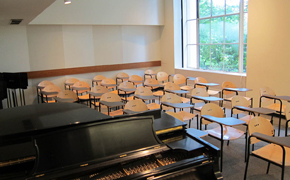Instructor Insights pages are part of the OCW Educator initiative, which seeks to enhance the value of OCW for educators.
Course Overview
This page focuses on the course 21M.S53 Chinese Popular Musics in Dialogue as it was taught by Dr. Meredith Schweig in Spring 2014.
This course introduced students to the major popular music cultures of the Chinese-speaking world. Emphasis was placed on listening beyond the notion of a monolithic “Chinese popular music” to something more dynamic, multivocal, and translocal. Interactive experiences, including contributing to a class blog, creating multimedia compositions through the use of Scalar, and conducting participant observation at a concert, were at the core of this course.
Course Outcomes
Course Goals for Students
- Gain familiarity with the repertoire of Chinese popular musics
- Become conversant in the recent scholarship about Chinese popular musics, and consider how the field might be pushed in new and interesting directions
- Develop popular music analysis and research skills, including the critical use and evaluation of online sources
- Learn how to integrate writing and rich media content in publications about popular musics
Curriculum Information
Prerequisites
Permission of Instructor
Requirements Satisfied
None
Offered
21M.S53 Chinese Popular Musics in Dialogue was offered for the first time in Spring 2014 as an experimental special subject, not part of the regular department curriculum.
Assessment
The students' grades were based on the following activities:
 30% Attendance and class participation
30% Attendance and class participation 5% Contributions to the class Tumblr
5% Contributions to the class Tumblr
 25% Short written assignments
25% Short written assignments 40% Multimedia research project & accompanying oral presentation
40% Multimedia research project & accompanying oral presentationStudent Information

Breakdown by Year
All undergraduates
Typical Student Background
The class was open to students with a variety of background experiences. No musical background was assumed. Likewise, it was not expected that students would have familiarity with the localities under discussion or knowledge of Mandarin. Source readings were in English, with translations provided whenever possible for non-English content.
During an average week, students were expected to spend 12 hours on the course, roughly divided as follows:
In Class
- Met 2 times per week for 1.5 hour every week; 26 sessions total; mandatory attendance.
- Sessions involved active class discussions and occasional in-class diagnostic quizzes.
Out of Class
- Class blog contributions
- Essay writing
- Curated mix tape creation
- Multimedia research project preparation
Semester Breakdown
| WEEK | M | T | W | Th | F |
|---|---|---|---|---|---|
| 1 |  |  |  |  |  |
| 2 |  |  |  |  |  |
| 3 |  |  |  |  |  |
| 4 |  |  |  |  |  |
| 5 |  |  |  |  |  |
| 6 |  |  |  |  |  |
| 7 |  |  |  |  |  |
| 8 |  |  |  |  |  |
| 9 |  |  |  |  |  |
| 10 |  |  |  |  |  |
| 11 |  |  |  |  |  |
| 12 |  |  |  |  |  |
| 13 |  |  |  |  |  |
| 14 |  |  |  |  |  |
| 15 |  |  |  |  |  |
| 16 |  |  |  |  |  |
 No classes throughout MIT
No classes throughout MIT Class session
Class session Final presentation
Final presentation No class session scheduled
No class session scheduled Field trip
Field trip Assignment due date
Assignment due date

 Room 1 of 1
Room 1 of 1 